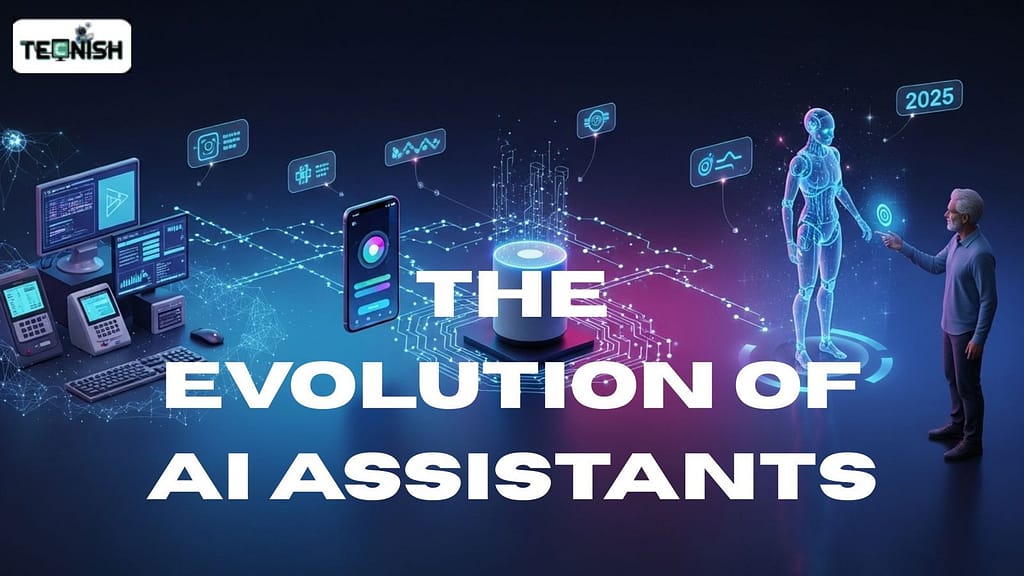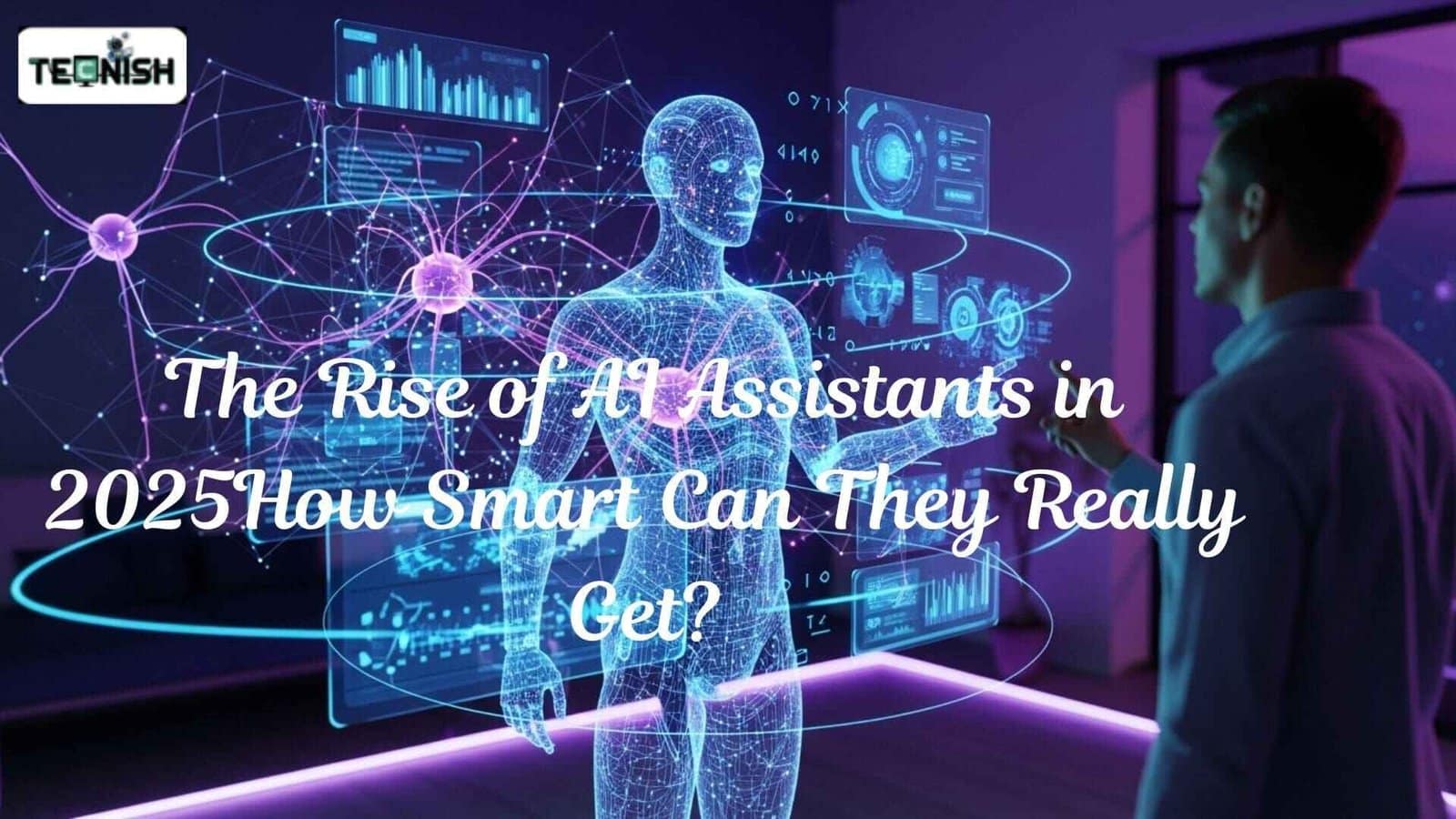Intro: Why 2025 Is a Turning Point for AI Assistants
By 2025, The Rise of AI Assistants in 2025 are set to deliver hyper-personalized, emotionally aware, and multimodal support, seamlessly handling tasks across work, smart homes, learning, and healthcare—while also raising critical questions about privacy, bias, and accountability.
AI assistants have evolved from simple rule-based systems into context-aware conversational partners capable of predictive suggestions and integrating voice, text, and image inputs with AI Assistants. For example, tools like Best AI Tools in 2025 Real World Uses, Smart Features showcase how AI now enhances productivity, creativity, and everyday decision-making in real-world scenarios.
What makes 2025 a pivotal year? The maturity of generative AI, immense computing power, and deep ecosystem integration across apps, devices, and cloud platforms. AI assistants no longer just follow commands—they proactively suggest next-best actions, understand tone, and adapt to context.
What you’ll learn at a glance:
- Core 2025 Capabilities: hyper-personalization, emotional intelligence, multimodal reasoning
2. Real-World Applications: productivity, smart homes, education, healthcare
3. Ethical Considerations: data privacy, bias, transparency, accountability
4. Beyond 2025: pathways to AGI, human-AI collaboration, workforce transformation, and emerging skill requirements
Ready to see how AI assistants are transforming our world and shaping the future? Let’s dive in.
The Evolution of AI Assistants

From Rule-Based Systems to Voice Commands
AI assistants didn’t start smart—they began with simple, rule-based systems. The earliest example is ELIZA, a 1960s program that followed predefined scripts to simulate conversation. Fast forward to the 2010s, and we had Apple Siri (2011), Amazon Alexa (2014), and Google Assistant, which brought voice interaction to smartphones and smart devices.
While these systems were revolutionary at their time, they had major limitations. They could only follow exact commands, lacked contextual understanding, and failed to handle nuanced human language. This restricted their usefulness beyond basic tasks like setting alarms, playing music, or providing weather updates.
NLP and NLU – From Words to Meaning
The real breakthrough came with Natural Language Processing (NLP) and Natural Language Understanding (NLU). These technologies allowed AI to go beyond keywords and understand the intent behind human communication.
Transformers like BERT and GPT models revolutionized conversational AI by learning context and patterns in massive datasets. This enabled AI assistants to grasp emotional tone, detect sarcasm, and provide responses that feel more human-like.
Today, your AI assistant can differentiate between “play that song” (a specific track) and “play a song” (any song from a genre), demonstrating a leap from literal command processing to context-aware intelligence.
Big Data and AI Training
Data is the fuel that powers modern AI. Today’s models are trained on 1,000x more data than a decade ago. For instance, GPT-4 has 1.7 trillion parameters, making it vastly more capable than its predecessors.
AI systems learn continuously through reinforcement learning, adapting from every interaction and user input. This ongoing training helps assistants become smarter, more accurate, and increasingly capable of predicting user needs before a command is even issued.
AI Assistants in 2025 – Key Capabilities to Expect

Hyper-Personalization and Predictive Assistance
By 2025, AI assistants will move far beyond reactive responses. They will anticipate your needs, delivering hyper-personalized suggestions based on your habits, location, preferences, and historical behavior.
- Examples:
- Commute: AI predicts traffic congestion and suggests alternative routes.
- Shopping: AI alerts you about discounts on items you frequently buy.
- Health: AI reminds you to take medications or schedule routine checkups.
- Commute: AI predicts traffic congestion and suggests alternative routes.
Leading AI entities driving this change include Google Gemini, Microsoft Copilot, Perplexity AI, and Apple Siri. According to Gartner, predictive and personalized AI services will be mainstream by 2025, improving user engagement and efficiency across both personal and professional contexts.
Conversational Fluency and Emotional Intelligence
Future AI assistants will not only understand your words—they will understand your feelings, tone, and intent.
- Capabilities:
- Detect sarcasm, humor, and stress.
- Offer encouragement or calm suggestions based on emotional cues.
- Tailor responses to match conversational style and context.
- Detect sarcasm, humor, and stress.
An example is Anthropic Claude, which uses constitutional AI principles to generate responses that align with ethical guidelines while maintaining conversational nuance. Source: Anthropic
This evolution allows interactions to feel more natural, reducing frustration and increasing trust in AI assistants.
Multimodal Understanding and Seamless Integration
AI assistants in 2025 will integrate voice, text, image, and IoT sensor data to understand complex queries and provide contextualized solutions.
- Example: Show a picture of an ingredient in your fridge, and the assistant instantly suggests recipes, nutritional info, and shopping alternatives.
- Example in the workplace: Upload a project document, and the AI summarizes key points while detecting missing tasks or deadlines.
Industry forecasts indicate that 30%+ of AI interactions will be multimodal by 2025 (Gartner), highlighting a major shift in how humans interact with AI—moving from single-modal commands to a fully integrated digital assistant experience.
Real-World Applications Transforming Daily Life

Productivity and Workflow Automation
AI assistants are transforming the way we work, making daily tasks faster, smarter, and more efficient. By 2025, they will handle complex workflows—from meeting summaries to task scheduling, report drafting, and data analysis—saving employees hours every week.
- Example: Microsoft Copilot integrates with Office and Teams to generate summaries of long meetings, draft emails, and suggest actionable items from notes.
- Impact: Users can focus on strategic decisions while routine administrative tasks are automated.
Authority reference: Microsoft Copilot Overview
Smarter Homes and Lifestyle Upgrades
AI assistants will make homes smarter and more responsive than ever. Beyond controlling lights or thermostats, they will predict energy usage, monitor appliance health, and even track groceries to reduce waste.
- Examples of Leading Entities:
- Amazon Alexa Smart Home for voice-controlled automation and predictive routines.
- Samsung SmartThings AI for integrating multiple IoT devices, managing security, and optimizing energy.
- Amazon Alexa Smart Home for voice-controlled automation and predictive routines.
- Impact: Personalized living becomes seamless; homes adapt automatically to family schedules, weather patterns, and even individual preferences.
AI in Education and Healthcare
AI assistants will redefine learning and healthcare, offering personalized support at scale.
- Education: AI tutors like Duolingo Max and Khanmigo adapt lessons to individual learning speeds, identify weak areas, and provide real-time feedback.
- Healthcare: AI streamlines scheduling, monitors health metrics via Apple Health + AI, and offers reminders for medication and appointments.
Case Study Suggestion:
- “A pilot study at Mayo Clinic (2024) showed AI assistance reduced doctor administrative workload by 30%, allowing more patient interaction time.”
Authority References:
Ethical Challenges of Smarter AI Assistants

Data Privacy and Security
AI assistants rely on voice inputs, location data, browsing history, and IoT device information to deliver personalized experiences. While this enables hyper-personalization, it raises significant privacy concerns. Users worry about how their data is stored, who can access it, and whether it might be used for targeted advertising without consent.
- Authority Reference: The EU AI Act (2025) sets strict regulations to protect personal data, enforce consent rules, and ensure accountability for AI providers.
- Impact: Users are encouraged to manage permissions and review privacy settings to maintain control over personal data.
Algorithmic Bias and Fairness
AI systems are only as unbiased as the data they are trained on. Studies show that approximately 25% of AI systems display bias, particularly in areas like job recommendations, loan approvals, and content filtering.
- Fixes:
- Training on diverse datasets to reduce demographic bias.
- Human oversight to review outputs and correct errors.
- Regular audits to ensure fairness and inclusivity.
- Training on diverse datasets to reduce demographic bias.
- Example: An AI recruiting assistant might inadvertently favor candidates from certain universities unless properly audited for bias.
Authority Reference: AI Fairness & Ethics Guidelines – IBM Research
Transparency and Accountability
Many AI assistants operate as a “black box”, making decisions without clear explanations. This lack of transparency can erode user trust and complicate accountability in critical applications.
- Solutions:
- Adoption of Explainable AI (XAI) techniques that provide clear reasoning for recommendations.
- Research from OpenAI and Anthropic focuses on improving transparency and ensuring AI decisions are interpretable.
- Adoption of Explainable AI (XAI) techniques that provide clear reasoning for recommendations.
- Example: An AI assistant suggesting health interventions should clearly explain why it recommends a particular action rather than simply giving instructions.
- Data Privacy Breaches
- Algorithmic Bias & Discrimination
- Lack of Transparency / Black Box Decisions
The Future Beyond 2025
The Path Toward Artificial General Intelligence (AGI)
Today’s AI assistants are examples of narrow AI, designed to excel at specific tasks such as scheduling, summarizing information, or generating recommendations. In contrast, Artificial General Intelligence (AGI) would possess the ability to perform any intellectual task a human can, ranging from creative problem solving to complex multi-domain reasoning.
While AGI remains a distant goal, current progress in narrow AI is laying the foundational blocks. According to a DeepMind researcher, “AGI is still 10–20 years away, but current progress in narrow AI lays the foundational blocks.”
Innovations in predictive algorithms, conversational AI, and multimodal reasoning are steadily bridging the gap between today’s assistants and the AGI vision.
Human-AI Collaboration
By 2025 and beyond, AI assistants will evolve from simple tools to creative collaborators, working alongside humans on both artistic and analytical projects. From co-writing music and film scripts to drafting research papers or simulating experiments, AI will enhance human productivity and creativity.
For instance, Adobe Firefly empowers creators to generate images, video effects, and design assets with AI assistance. Meanwhile, AI research assistants can compile literature reviews, draft technical papers, and even propose experimental simulations, acting as a reliable co-pilot rather than just a utility.
This type of human-AI partnership transforms workflows, allowing humans to focus on strategic thinking while AI handles routine, repetitive, or data-intensive tasks.
Authority Reference: Adobe Firefly Overview
Societal Impact and Workforce Transformation
The integration of AI assistants into daily life and workplaces will reshape industries, workforce structures, and skill requirements. According to PwC, 20–25% of jobs are expected to be impacted by AI by 2030, particularly those involving routine or repetitive tasks.
As AI handles administrative, analytical, and procedural responsibilities, human workers will need to focus on critical thinking, emotional intelligence, and AI collaboration skills.
Organizations will increasingly invest in upskilling programs, AI literacy initiatives, and prompt engineering training to prepare employees for AI-enhanced workflows.
Authority Reference: PwC AI Workforce Impact Report
Conclusion – A Balanced Future With AI
AI assistants are evolving at an unprecedented pace, moving from simple digital helpers to intelligent, context-aware collaborators capable of predicting needs, understanding emotions, and integrating multiple data sources.
As we look toward 2025 and beyond, their impact will extend across work, education, healthcare, and daily life—offering efficiency, personalization, and creativity like never before.
However, this rapid advancement comes with ethical responsibilities. Ensuring data privacy, fairness, and transparency will be critical to building trust between humans and AI. Likewise, preparing society for the workforce changes and collaborative opportunities ahead will determine whether AI becomes a true co-pilot for human potential or a disruptive force.
Takeaway: The future of AI is not just about technology—it’s about how we choose to use it responsibly. Smarter, ethical, and collaborative AI can enhance human lives, but only if we engage with it thoughtfully.
- “AI assistants are rapidly reshaping our world. Do you see them as partners or threats? Share your thoughts in the comments—or explore our guide on Future Jobs in the Age of AI to understand how to thrive in an AI-driven world.”
FAQ About of AI Assistants in 2025
Q1: What will AI assistants be able to do in 2025?
Ans: AI assistants will deliver hyper-personalized, multimodal, and emotionally intelligent support, assisting in daily work, smart home management, personalized learning, and healthcare tasks.
Q2: Will AI assistants replace human jobs?
Ans: While they will automate repetitive or administrative tasks, AI will also create new opportunities in AI development, ethics, human-AI collaboration, and creative fields.
Q3: Which AI assistants are leading in 2025?
Ans: Key players include Google Gemini, Microsoft Copilot, Amazon Alexa, Apple Siri, Anthropic Claude, and ChatGPT integrations, offering a mix of productivity, conversational, and multimodal capabilities.
Q4: How safe are AI assistants for daily use?
Ans: AI assistants are generally safe if proper privacy controls are followed. Users should review app permissions, data-sharing policies, and adhere to cybersecurity best practices to protect personal information.


One comment
[…] the easiest way to manage Gemini. And if you love reading about new AI trends, check out our post on The Rise of AI Assistants in 2025 for a deeper look at how these smart tools are changing […]